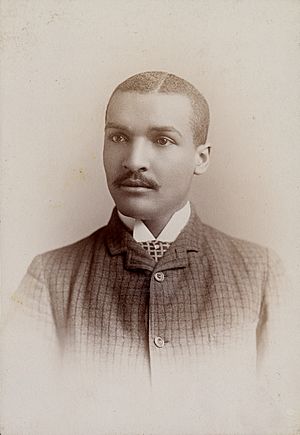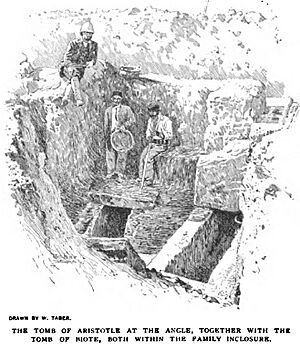John Wesley Gilbert facts for kids
Quick facts for kids
John Wesley Gilbert
|
|
|---|---|
 |
|
| Born | July 6, 1863 |
| Died | November 19, 1923 |
| Education | A.B, A.M, Brown University |
| Occupation | Professor at Paine College, President of Miles College, Archaeologist |
| Spouse(s) | Osceola Pleasant Gilbert (married 1889) |
| Children | 4 |
John Wesley Gilbert (born July 6, 1863 – died November 18, 1923) was an important American archaeologist, teacher, and Methodist missionary. He traveled to the Congo in Africa. Gilbert made history as the first person to graduate from Paine College. He was also the first African-American professor at Paine College. Plus, he was the first African-American to earn an advanced degree from Brown University.
Contents
Early Life and Education
John Wesley Gilbert was born in Hephzibah, Georgia. His parents were enslaved at the time. He grew up in nearby Augusta. He was named after John Wesley, who started the Methodist Church.
Gilbert spent half the year working on a farm. The other half he attended public schools in Augusta. After finishing public school, he went to the Augusta Institute. This school later became part of Morehouse College.
In 1884, Gilbert joined the new Paine Institute. This school was special because it was started by both white and Black Methodist churches. It aimed to bring people together. George Williams Walker, a minister and president of Paine, became a very important mentor to Gilbert. Gilbert later said that Dr. Walker was like a father to him.
Studying at Brown University
In 1886, Gilbert received help to transfer to Brown University. This was a big step. He was one of the first ten Black students to attend Brown. He was also among the few African-Americans to graduate from a northern university during that time.
Gilbert earned his bachelor's degree from Brown in 1888. He then returned to Georgia. In 1889, he married Osceola Pleasant. She was also a college graduate.
Exploring Ancient Greece
While at Brown University, John Wesley Gilbert received a special scholarship. It allowed him to study at the American School of Classical Studies in Athens, Greece. He was the first African American to attend this famous school.
Gilbert was given an award for being excellent in Greek. He spent time in Greece from 1890 to 1891. During this time, he helped with archaeological digs in a place called Eretria. He and another researcher, John Pickard, created the first map of Ancient Eretria. They even thought they found the "tomb of Aristotle," but this idea was later proven wrong.
For his amazing work in Greece, Gilbert earned his master's degree from Brown in 1891. He was the first African-American to receive an advanced degree from Brown. His master's paper was about "The Demes of Attica," which are like ancient Greek neighborhoods. Later, in 1897, he was honored by being chosen for the American Philological Association.
A Dedicated Educator
In 1891, Gilbert returned to Augusta, Georgia. He began teaching at his old school, Paine College. He taught many languages, including Greek, French, German, Latin, and Hebrew. His new job caused a stir because he was the first Black faculty member at Paine. Some teachers were not happy about this "revolutionary" change.
However, Gilbert's teaching was very important. He had a strong classical education. This meant he knew a lot about ancient Greek and Latin. These subjects were key for a college at that time. Students remembered him as a very strict teacher. He expected hard work and wouldn't accept weak excuses. He believed that only hard work made good scholars.
One story tells how he corrected a student's Greek verb. When the student said it was in the textbook, Gilbert replied, "Then the textbook is wrong. Bring it here." He proved the textbook was wrong, and it was changed in the next edition!
In 1913, Gilbert became the president of Miles College. He stayed there for one year. Then he returned to teach at Paine College again.
Missionary Work in Africa
In 1911 and 1912, John Wesley Gilbert went on a mission to the Belgian Congo in Africa. He went with Walter Russell Lambuth, a white bishop from the Methodist Church. Gilbert believed that Africa needed many teachers. He thought that Black teachers from American colleges would be perfect. He felt they understood the culture and were better suited for the climate.
Gilbert and Lambuth worked well together. Lambuth praised Gilbert's language skills. He said Gilbert's translations were so good that a government minister in Brussels asked who wrote them. Gilbert was passionate about languages. He even created a vocabulary and grammar guide for Tetela, a language spoken in the area where they worked.
Gilbert and Lambuth successfully started a church and a school in a village called Wembo-Nyama. This school later educated Patrice Lumumba. Lumumba became the first prime minister of the Democratic Republic of the Congo. Today, the school is called the Patrice-Emery-Lumumba University of Wembo-Nyama. American Methodists still support it.
Their mission was seen as a great example of Black and white people working together. However, it became harder for African Americans like Gilbert to return to the Congo. The Belgian government made it difficult. This was partly because of earlier protests against the terrible things that happened in the Congo under Belgian rule.



